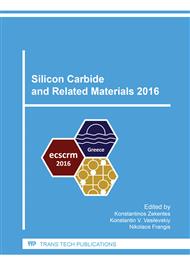p.197
p.201
p.205
p.209
p.214
p.218
p.222
p.226
p.233
Modeling of Stacking Fault Expansion Velocity of Body Diode in 4H-SiC MOSFET
Abstract:
We present a model to explain forward voltage degradation of body diode in 4H-SiC MOSFET, and evaluate the velocity of SF expansion. First, by using in-situ photoluminescence (PL) observation, we investigated how a stacking fault (SF) expands from a basal plane dislocations (BPD) in the 4H-SiC epitaxial layer. Second, double-diffused MOSFETs were developed and measured before and after degradation. Then, the characteristics of the forward voltage degradation were modeled by a combination of PL imaging and electrical measurement, and the calculated characteristics are in good agreement with the measured ones. Finally, we tested the SiC MOSFETs under various stress conditions and evaluated the velocity of the SF expansion by calculation. This results indicate that the velocity of SF expansion increased with increasing forward current density and junction temperature.
Info:
Periodical:
Pages:
214-217
Citation:
Online since:
May 2017
Authors:
Keywords:
Price:
Сopyright:
© 2017 Trans Tech Publications Ltd. All Rights Reserved
Share:
Citation:


